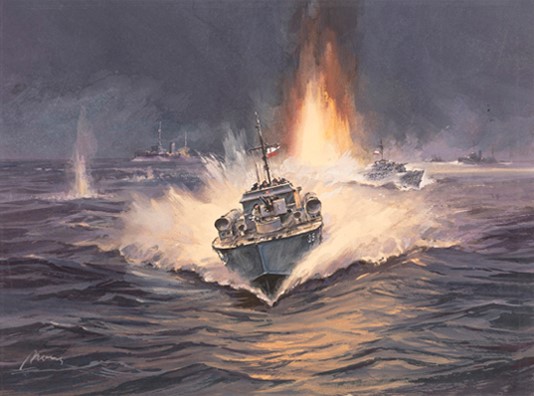In today's blog post Przemysław Budzbon introduces us to Poland's Navy.

Polish motor gunboats S-5 and S-6 in the Channel under fire from German coastal batteries on 29 August 1944, as depicted in a gouache by Polish painter Adam Werka. Since the early 1950s several generations of naval and maritime enthusiasts in Poland, including the author, have been brought up on Werka's maritime paintings.
(Marta Werka Collection)
Pranks of History
Recent events in Eastern Europe give the impression that history has come full circle. In May 1920, Poland and freshly independent Ukraine concluded a military alliance aimed at stopping the resurgence of Russian imperialism, this time under a red flag. Poland defended her independence then, while Ukraine had to wait another seventy years.
The Polish Navy fought its first battles against the Bolshevik Dnieper Flotilla at the Pripyat River near Chernobyl and the Dnieper near Kiev but ironically, most of the Polish officer corps were from the former Russian Imperial Navy. Officers of Russian nationality had been mercilessly eliminated by the Bolsheviks, and Bolshevik ships and flotillas were commanded by seamen or non-commissioned naval officers, if not by cavalry men. Polish motorboats armed with machine guns successfully confronted these Soviet steamers using 3in. guns, and helped by the high morale of their crews, defended their country once again against a power whose domination they had recently repulsed.
Four years later, in 1924, a Soviet squadron was spotted by a seaplane north of the Polish coast where the German Navy was conducting exercises near Bornholm, and radio communication of both fleets was intercepted. This dispelled the illusion that peace between Poland and the Soviet Union/Germany would last and spurred on the development of the Polish Navy which, despite being numerically inferior to the fleets of Germany and the Soviet Union, influenced the balance of power in the Baltic Sea over subsequent years.
The Polish fleet comprised the largest, most modern and most heavily armed ships in its respective classes. But, by 1935, both Germany and the Soviet Union had switched their economies to producing armaments and quickly outpaced Poland in naval development. In September 1939, the Polish fleet of four destroyers and five submarines stood little chance against the powerful German Kriegsmarine, and three Polish destroyers were dispatched to Britain to form the Polish Naval Detachment. On 1 September 1939, the remaining Polish fleet fought successfully against three squadrons of Stuka bombers during the battle of the Gulf of Danzig in the first naval-aerial battle of World War II, but within two weeks, the entire Polish fleet had been sunk by the Luftwaffe. The three Polish destroyers stationed in Britain were joined by two submarines which had escaped internment in the Baltic, and the backbone of a navy in exile was created which, augmented by British-built warships, developed into a small naval force of a cruiser, six destroyers, three submarines and five MTBs.
Polish troops and naval forces contributed widely to the Allied war effort and were involved in the Battle of the Atlantic, the Mediterranean, skirmishes in the Channel and the Normandy landings, a fact greatly appreciated by British allies. During the hunt for the Bismarck, a Polish destroyer Piorun drew fire for an hour from a distance of 8000yds in an attempt to assist other destroyers to launch torpedoes, and Polish motor gunboat S-2, acting alone, thwarted an attack by seven German E-boats on a British Channel convoy, damaging two of the boats and fooling the German crews into shooting each other. At the time, a British commentator said: “They are terrible fighters. Showing a German to them is worse than showing a hungry dog a bone.”
Despite Soviet aggression in 1939, which had aided the Wehrmacht invasion of Poland, Polish sailors served bravely during the Arctic Convoys, delivering supplies to their recent enemy.
In 1945, the Red Army pushed the Germans out of Polish territory and introduced Soviet law, managing to do what they hadn’t done in 1920. Polish sailors who subsequently returned to Poland were expelled from the navy or jailed, and 13, including war heroes, were executed.
It took almost 50 years for Poland to eventually shed the domination of the Soviet Union and, since 1999, it has been part of the NATO community. For the Ukraine, however, history has returned to its 1920 status, and we hope a good ending will be forthcoming there too.
NVG 307 The Polish Navy 1918–45: From the Polish-Soviet War to World War II describes the history of the Polish Navy during Poland’s fight for independence and its contribution to the Allied war effort during WWII.

Comments
You must be logged in to comment on this post. Click here to log in.
Submit your comment